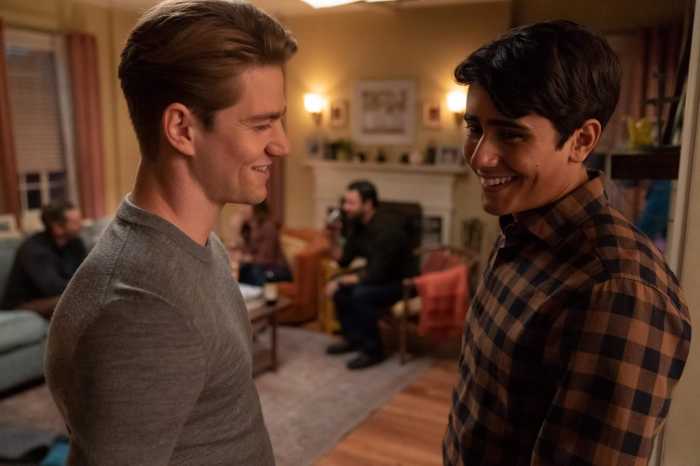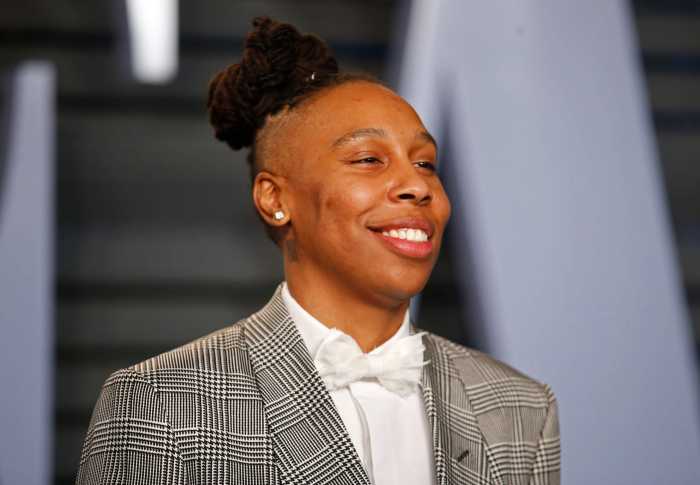The absorbing new TV series, “High School,” recreates the experiences of Tegan and Sara, the out gay twin musicians from Calgary, Alberta. This show, cowritten by out director Clea DuVall along with Tegan and Sara (and based on their memoir), tells the story of the sisters as teenagers in the mid-1990s. The first episode opens with the twins being angry at one another; Tegan (Railey Gilliland) feels shut out from Sara’s (Seazynn Gilliland) friendship with Phoebe (Olivia Rouyre). Unbeknownst to Tegan, Sara and Phoebe are girlfriends.
As they start a new high school, Tegan is mopey, and her mood doesn’t improve when a male classmate bullies her. When Maya (Amanda Fix) comes to Tegan’s rescue and befriends her, Tegan develops a crush on this tough, cool girl — although she keeps her feelings to herself. Meanwhile, Sara is brooding because Phoebe is attending a different school and she worries they will drift apart.
“High School” is told in mini episodes that present one character’s point of view to form a larger narrative. As such, Tegan’s perspective on the first day of school is contrasted with Sara providing each twin with experience around the same, or shared, event. Other segments chronicle supporting characters, including the teens’ mother, Simone (Cobie Smulders), her partner Patrick (Kyle Bornheimer) — they are not married — as well as Phoebe, and Maya, and other characters.
The prismatic approach provides real emotional investment. An early scene features Sara and Tegan each feeling isolated in their new school, and their dovetailing storylines show how they both unknowingly eat lunch alone, leaning against adjacent walls on the same corner. “High School” shifts back and forth between the twins expressing their independence and holding onto their codependence. (Maya does pointedly ask Tegan at one point why she “babysits” her sister rather than let go and be her own person). The scenes of Tegan and Sara together or apart have impact because viewers can see how each twin absorbs every dramatic moment.
Moreover, when Maya later feels pangs of jealousy regarding Tegan’s closeness with Sara, or when Phoebe contends with her mother’s disapproval after she and Sara are caught in bed together, the overlapping storylines become more engaging. When Phoebe tells Sara they cannot be together, Sara does not share her heartbreak and with anyone. Sara’s depression is then artfully presented in a tableau of scenes that illustrate her despair.
“High School” captures the teenage angst with aplomb, and the series balances its tonal shifts well without feeling forced. There are the highs of the twins attending a rave, the rush of doing drugs, and the regret after being caught and grounded.
Tegan and Sara’s relationship with Simone and Patrick is also central to the series. The twins often ask Simone for permission to do things, while acknowledging her overprotective nature. One amusing sequence shows Tegan and Sara calling home during a party — and how Simone calls them back to keep them on their toes.
Simone may be demanding, but she is also very accepting when Sara asks her to call Phoebe’s mother to smooth over the “sleepover” issue. In contrast, the more easygoing Patrick gets schooled when he says something homophobic and is corrected by one of the twins.
The teens’ lesbianism is certainly a strong underlying component of “High School,” but it is discretely addressed — in part because the twins are still figuring out their identities. They feel attraction, and sometimes act on it, but just as often do not express their feelings.
Music is another throughline in the series, and it is not until the fourth episode that the twins find Patrick’s guitar and start teaching themselves to play. (Each episode is aptly named after a Tegan and Sara song). Music soon takes over their lives — almost to the point of excluding everything and everyone else. Cue more drama with Maya, but also the introduction of a new, flirty character, Cass (Hannah Riley). And it is through music that the twins find a sense of purpose, working together writing songs and even getting the opportunity to perform at a party.
Relegating the music to the second half of the series is a wise choice to focus on the character arcs. (Most of the soundtrack features other musicians). The few Tegan and Sara songs are used mainly to show how they developed their musical talent and to express their feelings for each other, or when Tegan prepares a tape for Maya. There is also a dramatic build up to the finale, the twins’ first concert, which causes both of them to have personal and professional anxiety.
“High School” ends with some cliffhangers rather than showing Tegan and Sara’s future success, which feels appropriate. This “origin story” may be familiar to fans of the duo or those who read the memoir, but it is an enjoyable series that showcases Tegan and Sara’s tale well.
“High School” | On Amazon Freevee | Premieres with 4 episodes on Oct. 14 and then 2 episodes for the next 2 weeks





































